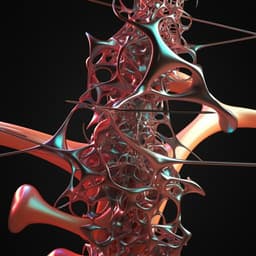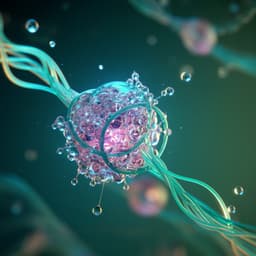
Medicine and Health
Manufacturing micropatterned collagen scaffolds with chemical-crosslinking for development of biomimetic tissue-engineered oral mucosa
A. Suzuki, Y. Kodama, et al.
This study by Ayako Suzuki and colleagues explores the development of biomimetic tissue-engineered oral mucosa using innovative micropatterned collagen scaffolds. By creating negative molds with various patterns, they significantly enhanced the mechanical properties of these scaffolds, paving the way for improved epithelial regeneration and tissue grafting applications.
~3 min • Beginner • English
Introduction
The study addresses the absence of physiologic undulating interfaces (rete ridges/dermal-epidermal junction, DEJ) in current epithelial tissue constructs. Rete ridges increase interfacial area, strengthen adhesion, and support nutrient exchange, and are niches for epithelial stem cells. Despite advances in biofabrication, clinically used constructs generally present flat, non-biomimetic interfaces. The authors previously created microstructured fish-scale collagen scaffolds but observed deformation (flattening and pitch expansion) in engineered oral mucosa equivalents (EVPOMEs), compromising biomimetic cues. Here, they aim to (1) design and fabricate a versatile set of negative molds to transfer varied 3D micropatterns onto collagen, (2) enhance scaffold mechanics via chemical crosslinking with 1-ethyl-3-(3-dimethylaminopropyl) carbodiimide (EDC) to improve shape fidelity and handling, and (3) evaluate histologic outcomes of EVPOMEs grown on these micropatterned scaffolds to promote rete ridge-like epithelial architecture.
Literature Review
The authors situate their work within regenerative engineering’s emphasis on 3D biomaterial microenvironments that modulate cell behavior. Prior studies showed micropatterned vascular grafts improving patency and endothelialization compared to non-patterned controls. The DEJ’s topography is recognized as crucial for tissue homeostasis and stem cell niches across epithelia (skin, oral, intestinal, gastric, corneal). Various micro/nanofabrication strategies (photolithography, soft lithography, electrospinning, 3D bioprinting, laser micropatterning) have replicated aspects of DEJ-like topographies, but many produce simple grooved patterns and few address oral mucosa with natural hydrogel scaffolds. The authors’ previous fish-scale collagen scaffolds replicated microstructures but deformed during culture. Crosslinking (e.g., EDC) is widely used to improve collagen matrix stability and mechanics, though it may affect degradation. The literature highlights the need for robust, biomimetic microtopographies on ECM-based hydrogels with suitable mechanics, and for methods enabling complex, stable DEJ-like geometries.
Methodology
Design and mold fabrication: Four micropattern prototypes were considered: grid-rectangular (G-R), grid-truncated (G-T), pillar-rectangular (P-R), and pillar-truncated (P-T). Fifteen negative molds with varied dimensions and aspect ratios (height, thickness, channel width at 200, 100, and 50 μm combinations) were designed to be smaller and with different aspect ratios than the prior study. Grid molds were fabricated on silicon using anisotropic deep reactive ion etching; truncated structures were formed by isotropic wet etching. PDMS was cast on Si grid patterns to create soft lithography molds. Si substrates with through-hole patterns (via anisotropic deep reactive ion etching) served as negative molds for pillar patterns. Mold features were verified by optical and confocal microscopy (n=3).
Collagen scaffold fabrication and crosslinking: A 1% (w/v) type I tilapia scale atelocollagen gel was prepared from freeze-dried collagen dissolved in HCl (pH 3.0) and mixed with D-PBS at 4 °C. Collagen solution was poured into PDMS or Si molds (or molds inverted into solution) and incubated at 25 °C to induce fibrillogenesis. Half of the gels underwent chemical crosslinking with 1% (w/v) EDC in 99.5% ethanol (100 mg EDC per 7.8 mg collagen) for 24 h at room temperature, followed by 24 h D-PBS washing under rotation. All scaffolds were γ-irradiated for sterilization. For simplifying handling, areas surrounding the 14-mm square micropattern were planarized.
Imaging and microstructure assessment: SEM characterized fibril networks and surface microstructures of EDC-crosslinked collagen matrices. Mold and transferred pattern fidelity were assessed via microscopy.
Mechanical testing and handling: Five 20-mm diameter, 2-mm thick collagen disks with or without 1% EDC (non-microstructured) were tested at 37 °C. Dynamic rheology (HAAKE MARS III) measured storage (G′) and loss (G″) moduli across frequency; compression speed 0.2 mm/s. Young’s modulus was measured with a universal tester (EZ-LX; 0.15 mm/s). Suturability was evaluated by placing gels on a Bio-SKIN model wound and suturing with 4-0 braided silk, documenting rupture versus durability.
Cells and EVPOME manufacturing: Human oral mucosa was obtained under IRB approval and consent. Primary keratinocytes were isolated (trypsin/EDTA digestion), expanded in EpiLife with supplements, and used at passages 3–5. Scaffolds (including AlloDerm positive control) were pre-coated with type IV collagen (5 μg/cm²) overnight at 4 °C. Keratinocytes were seeded at 1.5×10^5 cells/cm². Constructs were cultured submerged for 4 days (complete medium with 1.2 mM Ca2+) then at air–liquid interface for 7 days.
Macroscopic analysis and statistics: EVPOME diameters were measured daily (ImageJ). Paired t-tests compared day 11 diameters between crosslinked and non-crosslinked groups (n=5), with p<0.05 as significant.
Histology: Thirty-one EVPOMEs were fixed (4% paraformaldehyde), paraffin-embedded, sectioned (5 μm), and stained with H&E for microstructure preservation and epithelial architecture assessment.
Key Findings
- Pattern transfer and fidelity: Micropatterns were successfully replicated onto EDC-crosslinked collagen scaffolds across a wide range of geometries, including features as small as 50 μm. Grid-type configurations generally preserved microstructure better than pillar-type, which often collapsed, especially at larger heights. Image analyses indicated variations of mold dimensions were mostly within ±25% of design.
- Collagen fibril morphology: SEM showed well-developed fibril networks in EDC-crosslinked matrices with fibril diameters 40–120 nm, approximately 1.2× thicker than non-crosslinked in prior work.
- Mechanical properties: EDC crosslinking increased stiffness. Young’s modulus at 37 °C: ≈48.65 kPa (EDC+) vs ≈29.10 kPa (EDC−), substantially higher than ≈7.0 kPa reported previously for collagen with 1.0% chondroitin sulfate. Rheology showed G′>G″ across measured frequencies with G′ plateau, consistent with elastic gel behavior.
- Handling/suturability: EDC-crosslinked scaffolds tolerated suturing with 4-0 braided silk without rupture; non-crosslinked gels ruptured.
- Macroscopic contraction: EVPOMEs on EDC-crosslinked scaffolds exhibited minimal contraction over 11 days, whereas non-crosslinked constructs showed significant contraction, particularly for grid prototypes; non-crosslinked groups had large inter-sample variability in final diameters.
- Histology and epithelial formation: On EDC-crosslinked scaffolds, original microstructures were relatively well-preserved, supporting continuous, well-stratified epithelium with rete ridge-like architecture. Non-crosslinked scaffolds lost vertical dimensions and showed epithelial thickening due to scaffold contraction. Among designs, grid-type (especially G-R) yielded the most stable microstructures and epithelial organization. Pillar-type microstructures frequently collapsed even with EDC. Tiny gaps at sharp corner angles were observed between cells and scaffold.
Discussion
The work demonstrates a versatile soft-lithography/MEMS-based system to create complex DEJ-like micropatterns on natural collagen hydrogels and shows that EDC crosslinking substantially improves scaffold mechanics, pattern stability, and handling. These enhancements directly address prior failures of shape fidelity that undermined biomimetic cues for epithelial morphogenesis. Improved stiffness and preserved grid-type topography enabled formation of rete ridge-like epithelial architecture in EVPOMEs, indicating that appropriate microtopography combined with adequate mechanical integrity can guide keratinocyte stratification. The study situates soft lithography as a high-throughput, cost-effective alternative or complement to photolithography, electrospinning, and 3D bioprinting for engineering DEJ-mimetic microenvironments on ECM-based hydrogels. Remaining challenges include incomplete fidelity, particularly for pillar-type structures, potential deformation during processing due to viscoelasticity, and mechanical demands during epithelial maturation. The authors propose further engineering of mechanical properties (e.g., basement membrane-like layers, supramolecular crosslinkers) and geometric refinements (e.g., curved rather than right-angled features) to enhance cell–scaffold conformity and robustness. Marine collagen sources offer sustainable, potentially safer biomaterials for clinical translation.
Conclusion
This study establishes a manufacturing platform to replicate diverse DEJ-like microarchitectures onto fish-scale type I collagen scaffolds and shows that 1% EDC crosslinking improves mechanical strength, suturability, and microstructure preservation. Grid-type micropatterns, including features down to 50 μm, robustly supported well-stratified, rete ridge-like epithelial layers in tissue-engineered oral mucosa equivalents. These micropatterned, crosslinked collagen scaffolds are promising for intraoral and extraoral graft applications and as in vitro models of epithelial biology. Future work should focus on enhancing shape fidelity and mechanical resilience (e.g., basement membrane-like reinforcements, supramolecular crosslinkers), introducing curved microfeatures to improve cell-scaffold contact, employing non-invasive live 3D imaging to avoid fixation artifacts, and conducting in vivo studies to assess biodegradation, immunogenicity, and regenerative efficacy.
Limitations
- Incomplete shape fidelity, particularly for pillar-type microstructures, with loss of vertical dimensions under culture conditions.
- Viscoelastic nature of collagen introduces deformation during fixation and imaging, complicating accurate microstructure assessment.
- Tiny gaps at sharp corner angles indicate suboptimal cell–scaffold conformity; right-angle geometries may hinder attachment.
- Potential effects of EDC on in vivo degradation rates; no in vivo evaluation was performed.
- Variability in non-crosslinked groups and limited statistical reporting beyond contraction analyses.
- Short-term in vitro assessment without long-term functional outcomes or mechanotransduction analyses.
Related Publications
Explore these studies to deepen your understanding of the subject.







